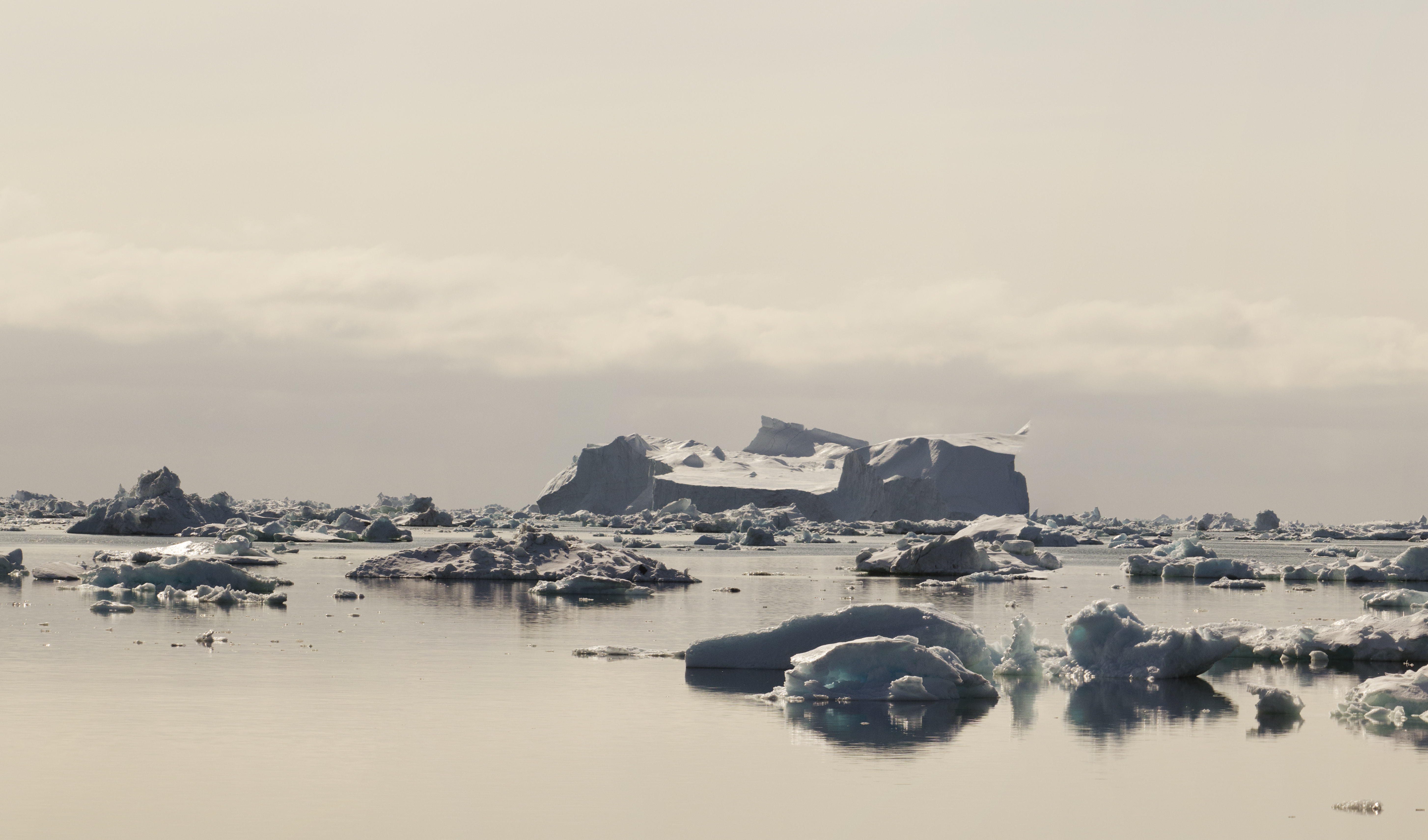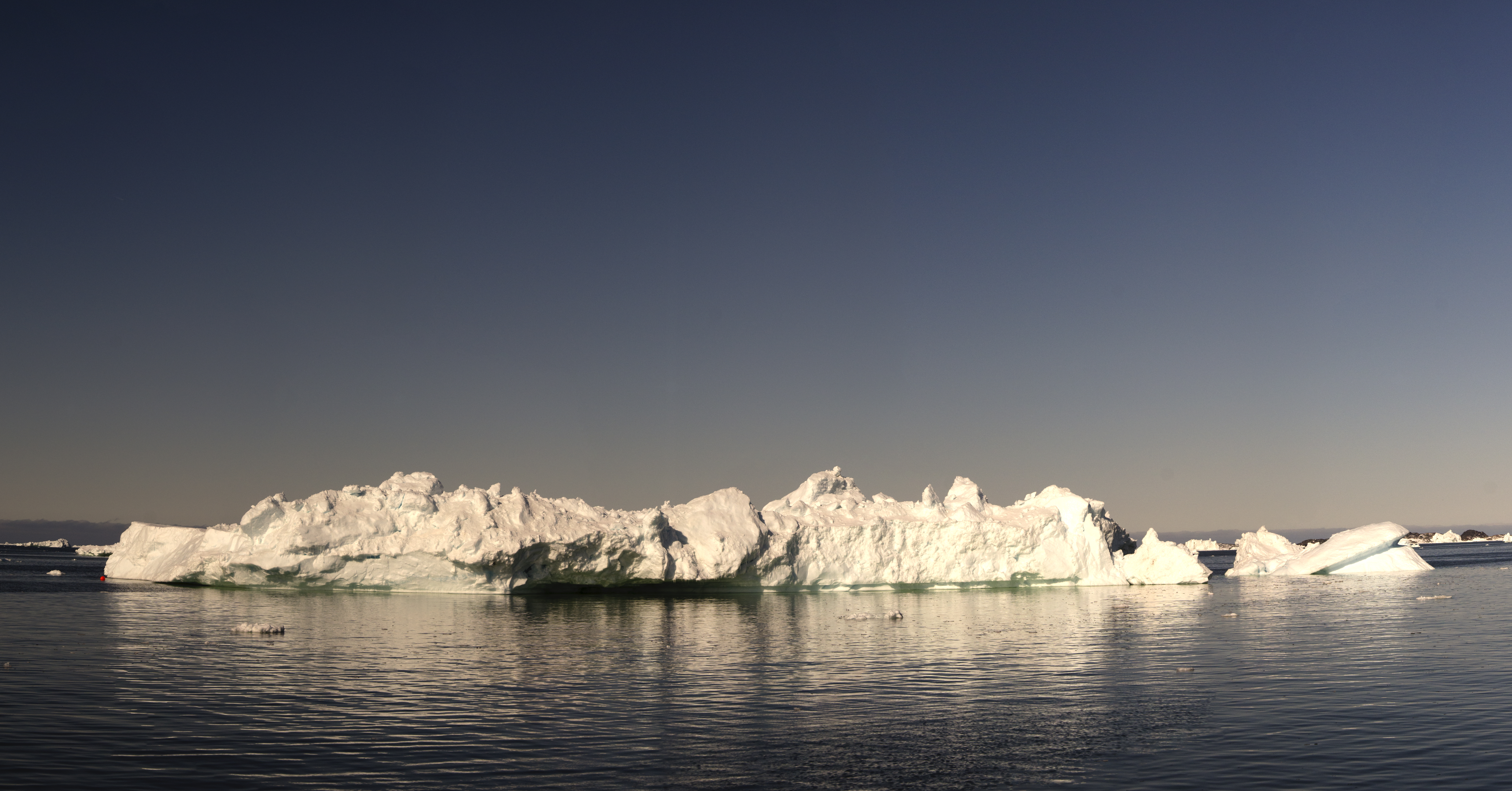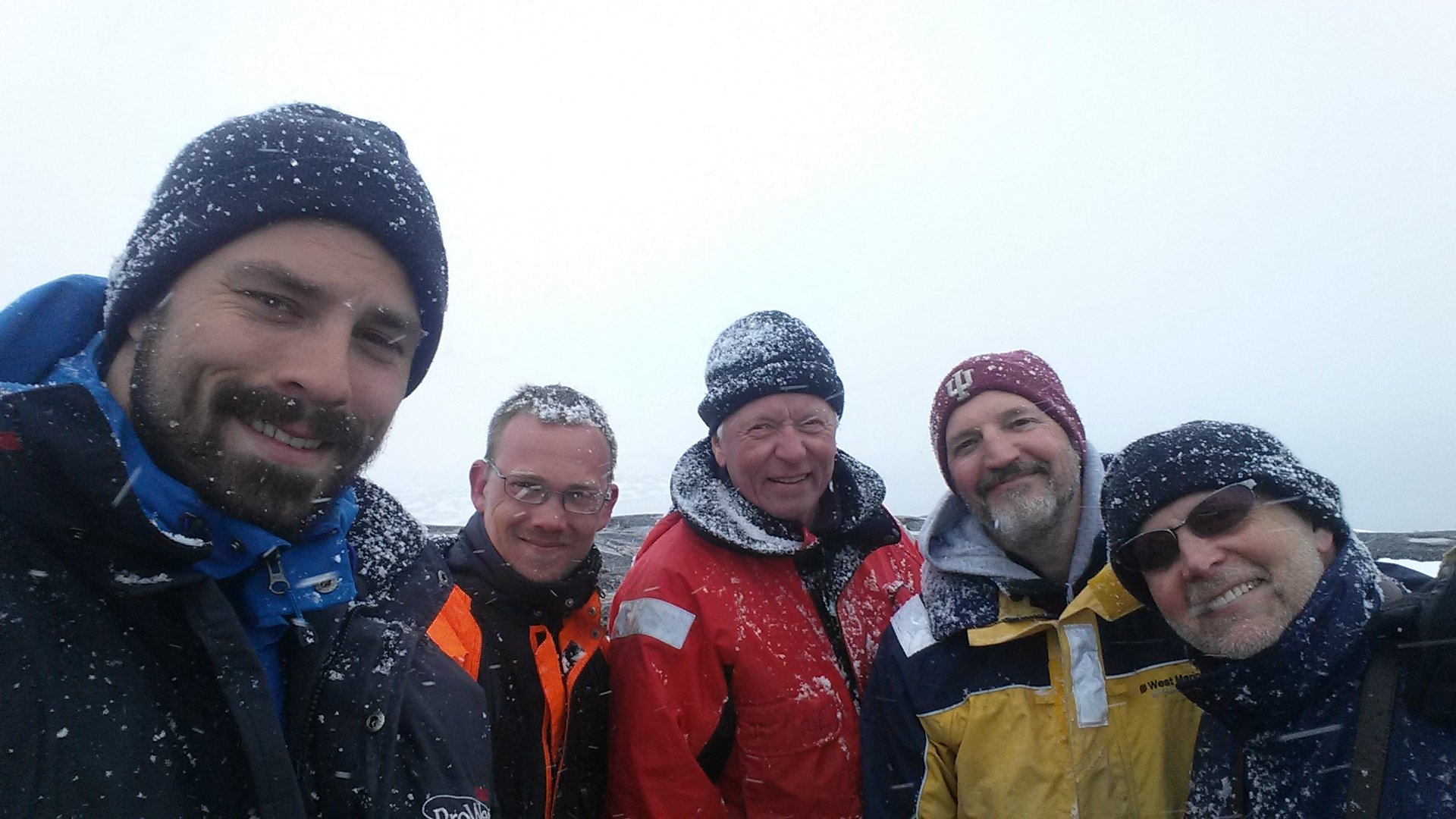Greenland Shark Expedition in Disko Bay (Greenland) May 2014
Written by Julius Nielsen, Peter Bushnell
Why study the Greenland shark?
The Greenland shark Somniosus microcephalus is one of the world’s largest carnivorous sharks, reaching at least 5.5 metres; only the great white shark is bigger. Besides being quite large, the Greenland shark is unusual in that it is one of the few shark species found in the cold, dark waters of the Arctic. Although we know very little about this shy creature, in recent years it has become the subject of increasing scientific focus for a number of reasons: its potential role as a top predator in the Arctic marine ecosystem; the disturbing fact that more than 1,000 individuals are taken annually as by-catch in the commercial fishery in Greenland waters; and, perhaps of greatest interest, its potential extreme longevity. We would like to learn as much as we can about the biology and ecology of this elusive species so that we can better understand its impact on the Arctic ecosystem and develop a long-term sustainable management plan to secure its future.
The expedition
In early May 2014 scientists from the University of Copenhagen (Denmark), Indiana University South Bend (USA), the Greenland Institute of Natural Resources (Greenland) and Den Blå Planet (National Aquarium of Denmark) visited the Arctic Station at Disko Island in western Greenland to investigate the biology and behaviour of Greenland sharks. This region is an important fishing area for Greenland halibut and deep-water shrimps, and Greenland sharks are thought to be quite abundant here, especially in spring. The main purpose of the expedition was to deploy pop-up satellite archival tags (PSATs) on Greenland sharks in order to get more information about the sharks’ vertical and horizontal movement patterns over long time periods.
A PSAT is a microcomputer that is attached to a shark and collects (and stores) information about the depth at which it swims and ambient water temperature and light levels. On a pre-programmed date, the tag becomes detached, floats to the surface and transmits the stored information to orbiting satellites overhead, which relay it to the researchers. The satellites also report the GPS position of the floating tag so the shark’s location when the tag was released is known.
The expedition was supported financially by Carlsberfondet and the Save Our Seas Foundation.
Long-lining in icy waters
Fishing operations were conducted from the research vessel Porsild, a 20-metre, steel-reinforced fishing boat modified to host scientific studies in ice-filled waters. The least harmful and most effective way to catch Greenland sharks is to use benthic long-lines. In essence, 10 baited hooks are attached at five-metre intervals to a long-line that is stretched and anchored to the bottom with heavy weights. From one end of the line, a buoy line runs to the surface and is attached to a float that marks its position and enables us to haul the long-line back.
The problem with fishing in Greenland’s waters in May is the risk of icebergs and drift ice tangling with the long-lines or buoy lines and carrying all the fishing gear away. Having been able to follow the ice conditions from satellite images in the weeks leading up to our departure, we believed the waters off the south coast of Disko Island would be relatively ice-free, as they normally are in that area at that time of year. In fact, that was the situation when we left Denmark on 5 May for the long journey to the Arctic Station. As the weather report had forecast favourable winds, we did not expect ice conditions to be much different when we arrived two days later.
We were therefore rather surprised (and disheartened) when the ferry carrying us on the last part of our journey was forced to push its way slowly through large swathes of densely packed sea ice south of Disko Island. Enormous icebergs, a major hazard to long-line fishing, were also present in large numbers, sailing majestically through the waters we were planning to fish in. A shift in wind direction over the past 30 hours was apparently responsible for this drastic change in ice conditions. It was immediately clear that this amount of ice would make our long-line fishing much more difficult and risky.
To avoid losing our long-lines to drifting ice, we therefore had to make some adjustments to our plans. We had come equipped with large (1-metre diameter) floating buoys to make the long-lines easier to spot, but now opted to use small (20-centimetre diameter) buoys and lighter bottom weights. Our theory was that whenever drifting ice came into contact with the smaller surface buoys or the buoy lines, either they would be dragged along the bottom together with the iceberg and would pop up later in a new position or, even better, the ice would force the buoys under water and glide right over them. The down side was that smaller buoys were much more difficult to locate among the large slabs of floating ice, especially if they had been dragged away from the position where they had been left the day before.
Greenland Shark expidition – Driftice Time-lapse from Save Our Seas Foundation on Vimeo.
© Julius Nielsen
Wolffish caught on shark bait
Being a bit nervous on the first day of fishing, we deployed only three long-lines and stayed in their vicinity to keep an eye on them and on the ice movement. After a soak time of six hours we recovered the lines, happy to have retrieved them without incident but disappointed that we had caught nothing. As average soak times for long-lines on previous expeditions had been between 12 and 24 hours, we decided to rebait the hooks and leave three lines overnight.
The next morning all three long-lines were found within 100 metres of where they had been deployed but, despite the increased soak times, there were no Greenland sharks on them. Surprisingly though, we caught several large spotted wolffish Anarhichas minor, which apparently liked the combination of rotten seal meat and squids that we had used as bait.
Wolffish are a common prey of Greenland sharks so we hoped that if the prey were present, the sharks would be there too. Unfortunately the ice conditions severely limited our fishing locations, as we were not happy about deploying long-lines in areas where we had been successful in the past. The small bay at the entrance to the harbour was the only site that was relatively protected from the densest ice and largest icebergs. We felt a bit more confident the following two days and deployed an additional four long-lines, which brought the same result as on day one: lots of wolffish but no sharks.
Video 2 wolffish from Save Our Seas Foundation on Vimeo.
© Julius Nielsen
Shark on the line
On the morning of day four, the wind had picked up and we headed out to retrieve our long-lines with some concern at the back of our minds. Our worries were justified: when we reached the fishing area we quickly realised that none of the seven lines were still where they had originally been deployed. The ice movement had apparently been much more powerful than on previous days. By watching the movement of the ice and current, we located six of the seven buoys quite quickly. We recovered the long-lines and, having seen that they had caught nothing but wolffish, we began looking for the missing buoy. For the next hour and a half all available personnel scoured the icy waters.
We eventually found the missing buoy more than two kilometres from its original position, having been dragged there by a huge iceberg that still had it in its clutches. Recovering the line would require Porsild to get within a metre or two of it, a manoeuvre that is not recommended due to the iceberg’s instability, which makes it unpredictable and potentially dangerous. The captain made a quick decision. He approached the iceberg at speed, we grabbed the buoy with a four-metre gaff and Porsild reversed rapidly to get clear.
This particular long-line would turn out to be memorable not only for the adventure involved in locating and retrieving it, but also because it held the first Greenland shark of the expedition. Unable to resist the mixture of rotten seal, squid and wolffish, the 2.7-metre male shark had taken the bait and been caught by the hook. Even though we knew from previous expeditions that the sharks sometimes take a while to be attracted to the bait, it was a big relief that we had caught the first one. Once we had cleared the rest of the long-line, we secured the shark to the side of the boat with a tail rope and took a small tissue sample from the fin for DNA analysis. In addition, we measured its length and girth and attached PSATs and two identification tags (in case it is ever caught again). When we had finished, we clipped off the barbed end of the hook and carefully removed the hook and tail rope before releasing the animal and sending it on its way.
Greenlandshark release from Save Our Seas Foundation on Vimeo.
© Julius Nielsen
‘Sleepy little brain’
Fishermen in Greenland have been catching these sharks for centuries and believe them to be lazy and stupid; when you see three-metre-long individuals lying quietly on the surface next to the boat, it is not difficult to imagine why. Nor is it difficult to understand why their scientific name is Somniosus microcephalus, which can be translated as ‘sleepy little brain’.
When caught on hooks, Greenland sharks are extremely docile and offer little resistance. To some degree this contradicts the growing belief that the Greenland shark is a top predator, hunting fast-swimming seals and fishes such as Atlantic cod and Greenland halibut. Watching the behaviour of Greenland sharks leads to the conclusion that their hunting strategy is different from that normally associated with a top predator; it’s more like a crocodile’s than a cheetah’s. The small copepod parasites often found dangling from the cornea of their eyes may be detrimental to the sharks’ eyesight, but there is little doubt that the species has a very well developed sense of smell; no Greenland shark will waste an opportunity for a free meal in the form of a dead seal or whale on the ocean floor.
Swimming with Greenland sharks
To ensure that tags were deployed only on sharks in perfect condition, a diver went into the water to check the sharks during handling and after release. We also had the opportunity to team up with a French expedition (Under the Pole – Underwater Polar Expedition), which included two divers capable of diving to a depth of 100 metres. The French divers successfully followed one of the sharks for as long as 25 minutes as it swam towards deeper water.
They also produced a short video as part of an outreach programme for French schoolchildren, which can be seen on YouTube at https://www.youtube.com/watch.
Only one shark did not survive the capture and handling process, having been severely injured by other Greenland sharks after it was caught on the long-line. This single specimen was brought to land for a thorough dissection. Although it is a shame that this one shark did not survive, it gave us the opportunity to take valuable tissue samples, such as from its liver, heart, brain, spleen and fatty tissue.
Greenland Shark dissection from Save Our Seas Foundation on Vimeo.
By the end of the trip, conditions were much better and the water was almost ice-free. In seven days of fishing we caught a total of 13 sharks ranging in size from 2.6 to 3.3 metres. Twelve PSATs were deployed and we hope that during the next six months this equipment will provide us with information about swimming depth, ambient water temperature and the shark’s migration route if it leaves the Disko Bay area. Such information about Greenland sharks is extremely sparse and can make a very important contribution to avoiding negative interactions with local fishermen and improving our understanding of seasonal dynamics in the presence or absence of Greenland sharks in the area.





